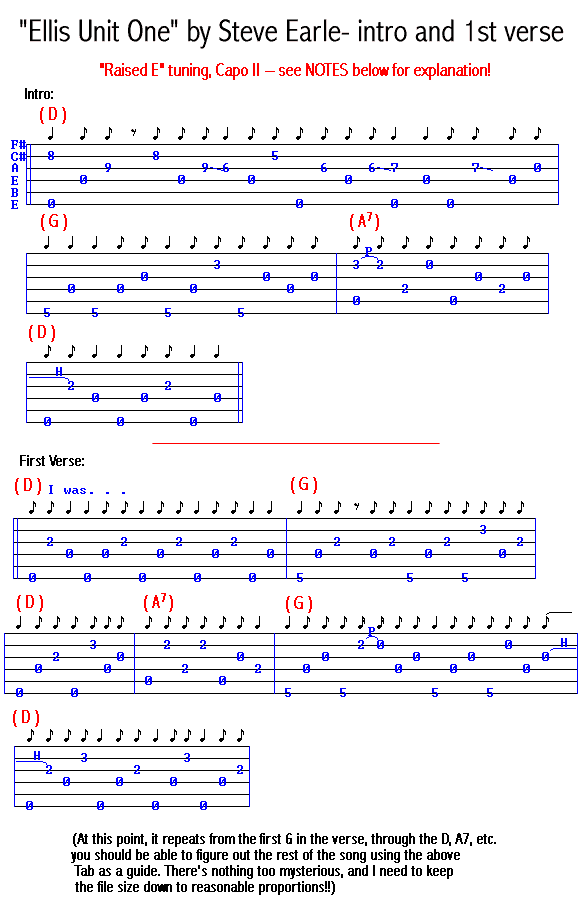Notes on the Tablature for "Ellis
Unit One" by Steve Earle:
This is the acoustic guitar part for the
intro and the first verse. The rest of the song is pretty similar;
you shouldn't have too much trouble figuring it out by using the Tab for
the verses as a basis.
Note that Steve is using a very unusual
tuning that I call "raised 'E'": you'll need a lever-type capo, like
the Kyser Loqo or the Shubb, or a "Third Hand" capo, to play this song.
An old-style "elastic band" capo won't work.
First, after tuning your guitar normally,
take your capo and turn it upside-down; that is, so that the open part
of the capo faces up instead of down. Then put it on your guitar
*from underneath*, at the 2nd fret, but put it on only partially -- you
want to cover all the strings *except* the low "E" string.
The effect of this is to give you the
sound of a "drop-D" tuning without having to re-tune.
I find that clamping the capo directly
*on* the fret instead of behind it minimizes tuning problems. Even
so, you may have to re-tune a little after putting the capo on.
Very important: the Tablature is
relative to the Capo *except* for the low "E" string. That is, if
the Tab says to play a note on the 3rd fret of one of the Capoed strings,
play it 3 frets up from the Capo; BUT if the Tab says to play the 3rd fret
of the low "E" string, play the *actual* 3rd fret of the low "E" string.
The song is played using the open chord
forms for "D", "G" and "A", but because of the Capo, the actual sounding
pitch will be "E", "A" and "B".
You'll find that this song is a good workout
for your fingerpicking skills. Steve uses a slightly modified alternating
thumb bass; it's pretty regular except for occasional spots where he drops
a note or two from the normal pattern. One of the trickier things
he does is to extend a hammer-on from one chord to the next. This
can cause problems if you don't listen carefully to the record. A
CD player with an "A-B" function helps tremendously here.
I have included rhythmic notation for
those of you who can read it, as the timing of the notes is crucial to
the successful playing of this song. Don't take the rhythms as an
indication for how long to hold the notes; they're just there for the rhythm
of the picking. Generally, you'll want to hold the notes as long
as possible before shifting fingering. Due to the distance between
the notes, I haven't connected the 8th note staffs. You may notice
that I haven't always put in the bar lines where they actually belong --
instead, I sometimes place them at chord changes & leave them out in
spots.
If you can't read the rhythm notation,
just ignore it! ;-) But be sure to listen closely to the record.
. .
Well, I hope I've helped to explain some
of the mystery behind this song. This was probably the toughest song
to actually Tab out, as there are so many little changes, & the mix
is such that his voice drowns out some of the little nuances.
I'm not claiming that my Tab is perfect,
but I sure sweated over it!! Corrections are welcome. . .
If any of you have further questions,
or would like to request the rest of the song (after *really* trying to
figure it out, I hope!), you can e-mail me at:
acushen@aol.com
(Andrew Cushen) http://users.aol.com/slideking/
Happy fingerpicking!!
![]()
